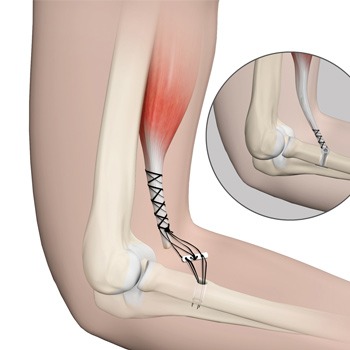- Anatomy
- Conditions
- Procedures
Elbow Arthroscopy
Elbow arthroscopy, also referred to as keyhole or minimally invasive surgery, is a surgical procedure that is performed through tiny incisions to evaluate and treat several elbow conditions.
UCL Reconstruction (Tommy John Surgery)
Commonly called Tommy John surgery, this procedure involves reconstructing a damaged ligament on the inside of the elbow called the ulnar or medial collateral ligament with a tendon graft obtained from your own body or a donor.
Tennis Elbow Surgery
Tennis elbow is a common name for the elbow condition lateral epicondylitis. It is an overuse injury that causes inflammation and microtears of the tendons that attach to the lateral epicondyle. Tennis elbow is a painful condition occurring from repeated muscle contractions at the forearm. The condition is more common in sports activities such as tennis, painting, hammering, typing, gardening and playing musical instruments.
Golfer’s Elbow Surgery
Golfer’s elbow is a condition associated with pain on the inside of the elbow where tendons of your forearm attach to the bony prominence (medial epicondyle). It is also called medial epicondylitis and is caused by injury or irritation to the tendons which can become painful and swollen. Besides golf, activities such as baseball or lifting a heavy bag or suitcase may also cause medial epicondylitis, hence the terms “baseball elbow” and “suitcase elbow” are also used.
Biceps Tendon Repair
Biceps tendon repair is a surgical procedure to restore a biceps tendon that has been torn or ruptured by severe trauma or injury. The biceps is a large muscle located in the front of your upper arm and runs from the shoulder to the elbow joint. It helps in bending your elbow as well as in rotational movements of your forearm. It also helps to maintain stability of the shoulder joint. The biceps muscle has two tendons, one of which attaches to the bone in the shoulder, and the other to the elbow. A biceps tendon tear can be either partial or complete. Partial biceps tendon tears will not completely cut the tendon. Complete tendon tears sever the tendon into two parts.
Distal Biceps Repair
The biceps is a large muscle located in the front of your upper arm and runs from the shoulder to the elbow joint. It is attached to the bones of the shoulder and elbow by tendons. The distal biceps is the area where the biceps is attached to the forearm bone in the elbow.
Common Extensor Tendon Origin Repair
The common extensor tendon is a tough band of fibrous connective tissue that attaches to the lateral epicondyle of the humerus (long bone in the upper arm) at the elbow. Rupture or tear of the common extensor tendon is the most common acute tendon injury of the elbow. The most frequent pathology of the common extensor tendon is epicondylitis and is characterized by loss of normal tendon structure.
Ulnar Nerve Release
Ulnar nerve release, also known as ulnar nerve decompression, is a surgical procedure to treat a medical condition called ulnar nerve entrapment. Ulnar nerve entrapment is a condition characterized by compression of the ulnar nerve by adjoining tissues most often at or near the elbow, specifically on the inner side of the elbow. Ulnar nerve entrapment can also occur less commonly near or at the wrist. As the ulnar nerve travels through the whole length of the arm, there are various places along the nerve that can become irritated or compressed. This irritation or compression is known as ulnar nerve entrapment.
Cubital Tunnel Release (Medial Epicondylectomy)
Cubital tunnel release is a surgical procedure to correct cubital tunnel syndrome. Cubital tunnel syndrome is a condition characterized by compression of the ulnar nerve in an area of the elbow called the cubital tunnel. The ulnar nerve travels down the back of the elbow behind the bony bump called the medial epicondyle, and through a passageway called the cubital tunnel. The cubital tunnel is a narrow passageway on the inside of the elbow formed by bone, muscle, and ligaments with the ulnar nerve passing through its center. The roof of the cubital tunnel is covered with a soft tissue called fascia.
Ulnar Nerve Transposition
The ulnar nerve is one of the 3 main nerves in the arm that travels down from the neck through a bony protuberance inside the elbow (medial epicondyle), under the muscles of the forearm and down the hand on the side of the palm, towards the little finger. The ulnar nerve helps in controlling most of the hand muscles which carry out fine movements as well as some bigger forearm muscles which help in making a strong grip.




















